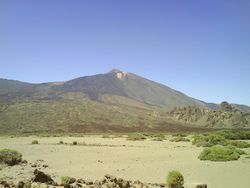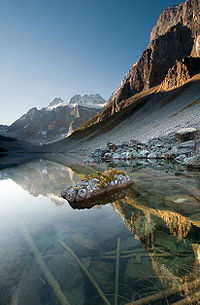National park
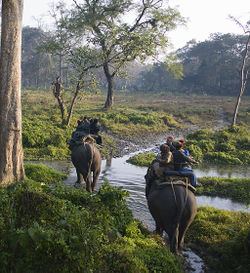
A national park is a reserve of natural or semi-natural land, declared or owned by a government, set aside for human recreation and enjoyment, animal and environmental protection and restricted from most development. While ideas for national parks had been suggested previously, the first one established, in 1872, was the United States' Yellowstone National Park, . An international organization, the International Union for Conservation of Nature (IUCN), and its World Commission on Protected Areas, has defined National Parks as its category II type of protected areas. The largest national park in the world meeting the IUCN definition is the Northeast Greenland National Park, which was established in 1974. According to the IUCN, there are about 7000 national parks worldwide (2010 figure)[3].
Contents |
Definitions
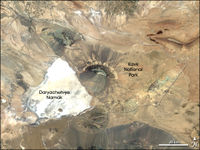
In 1969 the IUCN (International Union for the Conservation of Nature and Natural Resources) declared a national park to be a relatively large area with particular defining characteristics[4]. A national park was deemed to be a place
- with one or several ecosystems not materially altered by human exploitation and occupation, where plant and animal species, geomorphological sites and habitats are of special scientific, educative and recreative interest or which contain a natural landscape of great beauty.
- the highest competent authority of the country has taken steps to prevent or eliminate as soon as possible exploitation or occupation in the whole area and to enforce effectively the respect of ecological, geomorphological or aesthetic features which have led to its establishment.
- visitors are allowed to enter, under special conditions, for inspirational, educative, cultural and recreative purposes.
In 1971 these criteria were further expanded upon leading to more clear and defined benchmarks to evaluate a national park. These include:
- a minimum size of 1,000 hectares within zones in which protection of nature takes precedence
- statutory legal protection
- a budget and staff sufficient to provide sufficient effective protection
- prohibition of exploitation of natural resources (including the development of dams) qualified by such activities as sport, fishing, the need for management, facilities, etc.
While national parks are generally understood to be administered by national governments (hence the name), in Australia national parks are run by State Governments and predate the Federation of Australia.
History
In 1810, the English poet William Wordsworth described the Lake District as a
"sort of national property in which every man has a right and interest who has an eye to perceive and a heart to enjoy".
The painter George Catlin, in his travels through the American West, wrote in 1832 that the Native Americans in the United States might be preserved
"by some great protecting policy of government ...in a magnificent park ...A nation's park, containing man and beast, in all the wild and freshness of their nature's beauty!"
Similar ideas were expressed in other countries—in Sweden, for instance, the Finnish-born Baron Adolf Erik Nordenskiöld made such a proposition in 1880. The Scottish-American naturalist John Muir was inspirational in the foundation of national parks, anticipating many ideas of conservationism, environmentalism, and the animal rights movement.
The first effort by any government to set aside such protected lands was in the United States, on April 20, 1832, when President Andrew Jackson signed legislation to set aside four sections of land around what is now Hot Springs, Arkansas to protect the natural, thermal springs and adjoining mountainsides for the future disposal of the US government. It was known as the Hot Springs Reservation. However no legal authority was established and federal control of the area was not clearly established until 1877.
The next effort by any government to set aside such protected lands was, again, in the United States, when President Abraham Lincoln signed an Act of Congress on June 30, 1864, ceding the Yosemite Valley and the Mariposa Grove of Giant Sequoias (later becoming the Yosemite National Park) to the state of California:
"The said State shall accept this grant upon the express conditions that the premises shall be held for public use, resort, and recreation; shall be inalienable for all time." — U.S. Congress, 1864
In 1872, Yellowstone National Park was established as the world's first truly national park.[5] When news of the natural wonders of the Yellowstone were first promulgated, the land was part of a federally governed territory. Unlike Yosemite, there was no state government that could assume stewardship of the land, so the federal government took on direct responsibility for the park, a process formally completed in October 1, 1890—the official first national park of the United States. It took the combined effort and interest of conservationists, politicians and especially businesses—namely, the Northern Pacific Railroad, whose route through Montana would greatly benefit by the creation of this new tourist attraction—to ensure the passage of that landmark enabling legislation by the United States Congress to create Yellowstone National Park. Theodore Roosevelt, already an active campaigner and so influential as good stump speakers were highly necessary in the pre-telecommunications era, was highly influential in convincing fellow Republicans and big business to back the bill.
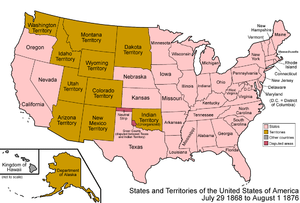
The "dean of western writers", American Pulitzer prize-winning author Wallace Stegner, has written that national parks are 'America's best idea,'—a departure from the royal preserves that Old World sovereigns enjoyed for themselves—inherently democratic, open to all, "they reflect us at our best, not our worst."[6] Even with the creation of Yellowstone, Yosemite, and nearly 37 other national parks and monuments, another 44 years passed before an agency was created in the United States to administer these units in a comprehensive way — the U.S. National Park Service (NPS). Businessman Stephen Mather and his journalist partner Robert Sterling Yard pushed hardest for the creation of the NPS, writing then-Secretary of the Interior Franklin Knight Lane about such a need and spearheading a large publicity campaign for their movement. Lane invited Mather to come to Washington, DC to work with him to draft and see passage of the NPS Organic Act, which was approved by Congress and signed into law on August 25, 1916. Of the 393 sites managed by the National Park Service of the United States, only 58 carry the designation of National Park.
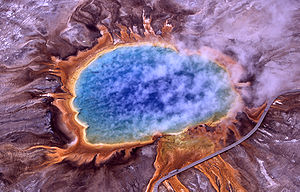
Following the idea established in Yellowstone there soon followed parks in other nations. In Australia, the Royal National Park was established just south of Sydney in 1879. Rocky Mountain National Park became Canada's first national park in 1885. New Zealand established Tongariro National Park in 1887. In Europe the first national parks were a set of nine parks in Sweden in 1909; Europe has some 359 national parks as of 2010.[7] Africa's first national park was established in 1925 when Albert I of Belgium designated an area of what is now Democratic Republic of Congo centred around the Virunga Mountains as the Albert National Park (since renamed Virunga National Park). In 1926, the government of South Africa designated Kruger National Park as the nation's first national park. After World War II, national parks were founded all over the world. The Vanoise National Park in the Alps was the first French national park, created in 1963 after public mobilization against a touristic project.
See also
- List of national parks (by country)
- National monument - in the United States
- Conservation movement
- conservation ecology
- Federal lands - in the United States
- Fossil park
- National Park Service - National Parks in the United States
- National Park Foundation
- National Parks Conservation Association
- International Network of Geoparks
- International Park
- Outdoor exploration
- National Forest
- Sustainable development
- United Nations Environment Programme
- The National Parks: America's Best Idea
- Provincial park
References
- ↑ El Teide, el parque más visitado de Europa y el segundo del mundo
- ↑ El parque nacional del Teide es el primero más visitado de Europa y el segundo del mundo
- ↑ http://www.exmoor-nationalpark.gov.uk/2006_feb_3
- ↑ Gulez, Sumer (1992). A method of evaluating areas for national park status.
- ↑ Mangan, Elizabeth U. Yellowstone, the First National Park from Mapping the National Parks. Library of Congress, Geography and Map Division.
- ↑ www.cr.nps.gov
- ↑ European National Parks Centre
Further reading
- Moore, Donald S. "CLEAR WATERS AND MUDDIED HISTORIES: ENVIRONMENTAL HISTORY AND THE POLITICS OF COMMUNITY IN ZIMBABWE'S EASTERN HIGHLANDS." Journal of Southern African Studies 24.2 (1998): 377-403. Historical Abstracts. EBSCO. Web. 18 Feb. 2010.
- Kahrom, Esmail. "WILDLIFE CONSERVATION IN IRAN." Asian Affairs 31.1 (2000): 49-56. Historical Abstracts. EBSCO. Web. 18 Feb. 2010.
- Yochim, Michael J. "Beauty and the Beet: The Dam Battles of Yellowstone National Park" Montana: The Magazine of Western History, Vol. 53, No. 1 (Spring, 2003), pp. 14–27; Montana Historical Society.
- Faulkner, Sandra M. "CELEBRATING ALASKA'S PAST: THE NATIONAL PARK SERVICE IN SITKA" Alaska History; 1989 4(2): 48-56, 9p.
- Sandlos, John. "NOT WANTED IN THE BOUNDARY: THE EXPULSION OF THE KEESEEKOOWENIN OJIBWAY BAND FROM RIDING MOUNTAIN NATIONAL PARK." Canadian Historical Review 89.2 (2008): 189-221. America: History & Life. EBSCO. Web. 18 Feb. 2010.
- Olson, Kent W.; Moomaw, Ronald L.; and Thompson, Richard P. "REDWOOD NATIONAL PARK EXPANSION: IMPACT ON OLD-GROWTH REDWOOD STUMPAGE PRICES" Land Economics; 1988 64(3): 269-275, 7p.
- Robins, Steven, and Kees van der Wall. "'MODEL TRIBES' AND ICONIC CONSERVATIONISTS? THE MAKULEKE RESTITUTION CASE IN KRUGER NATIONAL PARK." Development & Change 39.1 (2008): 53-72. Historical Abstracts. EBSCO. Web. 18 Feb. 2010.
- Lunstrum, Elizabeth. "MOZAMBIQUE, NEOLIBERAL LAND REFORM, AND THE LIMPOPO NATIONAL PARK." Geographical Review 98.3 (2008): 339-355. Historical Abstracts. EBSCO. Web. 18 Feb. 2010.
- Smurr, Robert W. "LAHEMAA: THE PARADOX OF THE USSR'S FIRST NATIONAL PARK." Nationalities Papers 36.3 (2008): 399-423. Historical Abstracts. EBSCO. Web. 18 Feb. 2010.
- McCracken, John. "IMAGINING THE NYIKA PLATEAU: LAURENS VAN DER POST, THE PHOKA AND THE MAKING OF A NATIONAL PARK." Journal of Southern African Studies 32.4 (2006): 807-821. Historical Abstracts. EBSCO. Web. 18 Feb. 2010.
- Colten, Craig E., and Lary M. Dilsaver. "THE HIDDEN LANDSCAPE OF YOSEMITE NATIONAL PARK." Journal of Cultural Geography 22.2 (2005): 27-50. America: History & Life. EBSCO. Web. 18 Feb. 2010.
- Bradford, Tolly. "A USEFUL INSTITUTION: WILLIAM TWIN, 'INDIANNESS,' AND BANFF NATIONAL PARK, C. 1860-1940." Native Studies Review 16.2 (2005): 77-98. America: History & Life. EBSCO. Web. 18 Feb. 2010.
- Murton, James. "NATIONAL PARKS: WHAT ARE THEY GOOD FOR?." BC Studies 136 (2002): 111-115. America: History & Life. EBSCO. Web. 18 Feb. 2010.
- Moye, J. Todd. "THE TUSKEGEE AIRMEN ORAL HISTORY PROJECT AND ORAL HISTORY IN THE NATIONAL PARK SERVICE." Journal of American History 89.2 (2002): 580-587. America: History & Life. EBSCO. Web. 18 Feb. 2010.
- Mirams, Sarah. "'FOR THEIR MORAL HEALTH': JAMES BARRETT, URBAN PROGRESSIVE IDEAS AND NATIONAL PARK RESERVATION IN VICTORIA." Australian Historical Studies 33.120 (2002): 249-266. Historical Abstracts. EBSCO. Web. 18 Feb. 2010.
- Mair, John, and John Delafons. "THE POLICY ORIGINS OF BRITAIN'S NATIONAL PARKS: THE ADDISON COMMITTEE 1929-31." Planning Perspectives 16.3 (2001): 293-309. Historical Abstracts. EBSCO. Web. 18 Feb. 2010.
- Patin, Thomas. "EXHIBITIONS AND EMPIRE: NATIONAL PARKS AND THE PERFORMANCE OF MANIFEST DESTINY." Journal of American Culture 22.1 (1999): 41-59. America: History & Life. EBSCO. Web. 18 Feb. 2010.
- Carruthers, Jane. "DISSECTING THE MYTH: PAUL KRUGER AND THE KRUGER NATIONAL PARK." Journal of Southern African Studies 20.2 (1994): 263-283. Historical Abstracts. EBSCO. Web. 18 Feb. 2010.
- Wikle, Thomas A. "PROPOSALS, ABOLISHMENTS, AND CHANGING STANDARDS FOR U.S. NATIONAL PARKS." Historian 54.1 (1991): 49-64. America: History & Life. EBSCO. Web. 18 Feb. 2010.
- Shelton, M. L. "SURFACE-WATER FLOW TO EVERGLADES NATIONAL PARK." Geographical Review 80.4 (1990): 355-369. America: History & Life. EBSCO. Web. 18 Feb. 2010.
- Vale, Thomas R. "VEGETATION CHANGE AND PARK PURPOSES IN THE HIGH ELEVATIONS OF YOSEMITE NATIONAL PARK, CALIFORNIA." Annals of the Association of American Geographers 77.1 (1987): 1-18. America: History & Life. EBSCO. Web. 18 Feb. 2010.
- Lowry, William R. "CAN BUREAUCRACIES CHANGE POLICY?." Journal of Policy History 20.2 (2008): 287-306. America: History & Life. EBSCO. Web. 18 Feb. 2010.
- Anderson, Terry L., and Peter J. Hill. "APPROPRIABLE RENTS FROM YELLOWSTONE PARK: A CASE OF INCOMPLETE CONTRACTING." Economic Inquiry 34.3 (1996): 506-518. America: History & Life. EBSCO. Web. 18 Feb. 2010.
- Hardy-Short, Dayle C., and C. Brant Short. "FIRE, DEATH, AND REBIRTH: A METAPHORIC ANALYSIS OF THE 1988 YELLOWSTONE FIRE DEBATE." Western Journal of Communication 59.2 (1995): 103-125. America: History & Life. EBSCO. Web. 18 Feb. 2010.
- John, Gareth E. "YELLOWSTONE AS 'LANDSCAPE IDEA': THOMAS MORAN AND THE PICTORIAL PRACTICES OF GILDED-AGE WESTERN EXPLORATION." Journal of Cultural Geography 24.2 (2007): 1-29. America: History & Life. EBSCO. Web. 18 Feb. 2010.
- Waggoner, Paul E., Jesse H. Ausubel, and Iddo K. Wernick. "LIGHTENING THE TREAD OF POPULATION ON THE LAND: AMERICAN EXAMPLES." Population & Development Review 22.3 (1996): 531-545. America: History & Life. EBSCO. Web. 18 Feb. 2010.
- Clarke, Jeanne N. "GRIZZLIES AND TOURISTS." Society 27.2 (1990): 23-32. America: History & Life. EBSCO. Web. 18 Feb. 2010.
External links
- National Parks Worldwide
- Vietnam National Parks
- UNESCO — Man and the Biosphere Programme (Biosphere Reserves)
- World Heritage Sites
- UN Protected Areas database
- EUROPARC Federation — Europe's protected areas
- European National Parks Centre (ENPC)
- National Park of China
- Pictures of European national parks
